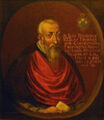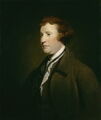Template:Selected anniversaries/November 1: Difference between revisions
No edit summary |
No edit summary |
||
| (40 intermediate revisions by the same user not shown) | |||
| Line 1: | Line 1: | ||
<gallery | <gallery> | ||
File: | || *** DONE: PICS *** | ||
File: | ||1520: The Strait of Magellan, the passage immediately south of mainland South America connecting the Pacific and the Atlantic Oceans, is first discovered and navigated by European explorer Ferdinand Magellan during the first recorded circumnavigation voyage. | ||
File: | File:Jan Brożek.jpg|link=Jan Brożek (nonfiction)|1585: Mathematician, physician, and astronomer [[Jan Brożek (nonfiction)|Jan Brożek]] born. Brożek will contribute to a greater knowledge of Nicolaus Copernicus' theories, and be Copernicus' ardent supporter and early prospective biographer. | ||
File: | |||
File: | ||1730: Luigi Ferdinando Marsili dies ... scholar and eminent natural scientist, who also served as an emissary and soldier. Pic. | ||
File: | |||
File:Edmund Burke 1771.jpg|link=Edmund Burke (nonfiction)|1790: [[Edmund Burke (nonfiction)|Edmund Burke]] publishes ''Reflections on the Revolution in France'', in which he predicts that the [[French Revolution (nonfiction)|French Revolution]] will end in a disaster. | |||
File: | |||
File: | ||1793: Johann Friedrich von Eschscholtz born ... physician and botanist ... traveler. Pic. | ||
||1804: Johann Friedrich Gmelin dies ... naturalist, botanist, entomologist, herpetologist and malacologist. Pic. | |||
||1815: Crawford Long born ... surgeon and pharmacist ... sulfur ether anaesthetic. Pic. | |||
||1828: Balfour Stewart born ... physicist. His studies in the field of radiant heat led to him receiving the Rumford Medal of the Royal Society in 1868. Pic. | |||
||1847: Organ and piano maker maker Cyrill Demian dies ... accordion patent. No DOB. Pic search yes: https://www.google.com/search?q=Cyrill+Demian&oq=Cyrill+Demian | |||
||1864: Ludwig Schlesinger born ... mathematician known for the research in the field of linear differential equations. Pic. | |||
||1870: In the United States, the Weather Bureau (later renamed the National Weather Service) makes its first official meteorological forecast. | |||
||1879: Oskar Barnack born ... optical engineer, precision mechanic, industrial designer, and the father of 35 mm photography. Pic. | |||
||1880: Alfred Wegener born ... meteorologist and geophysicist. Pic. | |||
||1894: Thomas Edison films American sharpshooter Annie Oakley, which is instrumental in her hiring by Buffalo Bill for his Wild West Show. Pic. | |||
||1897: Leonhard Sohncke dies ... mathematician who classified the 65 space groups in which chiral crystal structures form, called Sohncke groups. Pic. | |||
||1897: The first Library of Congress building opens its doors to the public; the library had previously been housed in the Congressional Reading Room in the U.S. Capitol. | |||
||1911: Donald William Kerst born ... physicist who worked on advanced particle accelerator concepts (accelerator physics) and plasma physics. He is most notable for his development of the betatron, a novel type of particle accelerator used to accelerate electrons. Pic. | |||
||1913: Andrzej Mostowski born ... mathematician. He is perhaps best remembered for the Mostowski collapse lemma. Pic (math). | |||
||1919: Hermann Bondi born ... mathematician and cosmologist. Pic. | |||
||1920: Claude Ambrose Rogers born ... mathematician who worked in analysis and geometry. Pic. | |||
||1926: James Burton Serrin born ... mathematician, and a professor at University of Minnesota. Pic search: https://www.google.com/search?q=James+Serrin+mathematician | |||
File:Alice and Niles Dancing.jpg|link=Alice and Niles Dancing|1932: Broadway production based on famed illustration ''[[Alice and Niles Dancing]]'' is a smash hit. | |||
||1924: Johannes Brückner dies ... geometer, known for his collection of polyhedral models. Pic (models). | |||
||1938: Seabiscuit defeats War Admiral in an upset victory during a match race deemed "the match of the century" in horse racing. | |||
||1951: Operation Buster–Jangle: Six thousand five hundred American soldiers are exposed to 'Desert Rock' atomic explosions for training purposes in Nevada. Participation is not voluntary. Pic: https://commons.wikimedia.org/wiki/File:Exercise_Desert_Rock_I_(Buster-Jangle_Dog)_002.jpg | |||
||1952:The United States successfully detonates Ivy Mike, the first thermonuclear device, at the Eniwetok atoll. The explosion had a yield of ten megatons TNT equivalent. | |||
||1954: John Lennard-Jones dies ... mathematician who was a professor of theoretical physics at University of Bristol, and then of theoretical science at the University of Cambridge. He may be regarded as the initiator of modern computational chemistry. Pic. | |||
||1954: Wallace Akers dies ... chemist and industrialist. Beginning his academic career at Oxford he specialized in physical chemistry. During the Second World War, he was the director of the Tube Alloys project, a clandestine programme aiming to research and develop British atomic weapons capabilities Pic. | |||
||1962: Thomas Murray MacRobert dies ... mathematician. He became professor of mathematics at the University of Glasgow and introduced the MacRobert E function, a generalisation of the generalised hypergeometric series. Pic: https://www.universitystory.gla.ac.uk/biography/?id=WH2053&type=P | |||
||1963: The Arecibo Observatory in Arecibo, Puerto Rico, with the largest radio telescope ever constructed, officially opens. | |||
File:Ludwig Roth - 1960.jpg|link=Ludwig Roth (nonfiction)|1967: Aerospace engineer and weapons designer [[Ludwig Roth (nonfiction)|Ludwig Roth]] dies. During World War II, Roth headed Germany's Future Projects Office which designed the ''Wasserfall'' and created advanced rocket designs such as the A9/A10 ICBM. Near the end of the war, Roth was recruited by American intelligence under Operation Paperclip. | |||
File:Nixon April-29-1974.jpg|link=Watergate scandal (nonfiction)|1973: [[Watergate scandal (nonfiction)|Watergate scandal]]: Leon Jaworski is appointed as the new Watergate Special Prosecutor. | |||
||1979: Leonard Jimmie Savage dies ... mathematician and statistician. Savage's most noted work was the 1954 book ''The Foundations of Statistics'', in which he put forward a theory of subjective and personal probability and statistics which forms one of the strands underlying Bayesian statistics and has applications to game theory. He was one the participants to the Macy conferences on cybernetics. Pic search yes: https://www.google.com/search?q=leonard+jimmie+savage | |||
||1989: Gerrit Bol dies ... mathematician, who specialized in geometry. He is known for introducing Bol loops in 1937, and Bol’s conjecture on sextactic points. Pic. | |||
File:Severo Ochoa.jpg|link=Severo Ochoa (nonfiction)|1993: Biochemist and academic [[Severo Ochoa (nonfiction)|Severo Ochoa]] dies. In 1959, Ochoa and Arthur Kornberg were awarded the Nobel Prize for Physiology or Medicine "for their discovery of the mechanisms in the biological synthesis of ribonucleic acid and deoxyribonucleic acid". | |||
||1996: Maxwell or Max Erich (Eric) Reissner dies ... civil engineer and mathematician. He is remembered by the New York Times (1996) as the "mathematician whose work in applied mechanics helped broaden the theoretical understanding of how solid objects react under stress and led to advances in both civil and aerospace engineering." Pic. | |||
File:Theodore Hall ID badge.png|link=Theodore Hall (nonfiction)|1999: American physicist and Soviet spy [[Theodore Hall (nonfiction)|Theodore Hall]] dies. During his work on US efforts to develop the first and second atomic bombs during World War II (the Manhattan Project), Hall gave Soviet intelligence a detailed description of the "Fat Man" plutonium bomb, along with several processes for purifying plutonium. | |||
||2006: Leon Albert Henkin dies ... logician at the University of California, Berkeley. He was principally known for "Henkin construction", his version of the proof of the semantic completeness of standard systems of first-order logic. Pic. | |||
||2008: Jacques Piccard dies ... oceanographer and engineer. Pic. | |||
||2015: Charles Duncan Michener dies ... entomologist ... leading expert on bees, his magnum opus being ''The Bees of the World''. Michener's work on social evolution in the Halictidae in the 1960s helped set the stage for the sociobiology revolution of the 1970s, with E. O. Wilson relying to a great degree on Michener's concepts regarding the paths from solitary to highly social life. Pic. | |||
</gallery> | </gallery> | ||
Latest revision as of 19:52, 20 November 2021
1585: Mathematician, physician, and astronomer Jan Brożek born. Brożek will contribute to a greater knowledge of Nicolaus Copernicus' theories, and be Copernicus' ardent supporter and early prospective biographer.
1790: Edmund Burke publishes Reflections on the Revolution in France, in which he predicts that the French Revolution will end in a disaster.
1932: Broadway production based on famed illustration Alice and Niles Dancing is a smash hit.
1967: Aerospace engineer and weapons designer Ludwig Roth dies. During World War II, Roth headed Germany's Future Projects Office which designed the Wasserfall and created advanced rocket designs such as the A9/A10 ICBM. Near the end of the war, Roth was recruited by American intelligence under Operation Paperclip.
1973: Watergate scandal: Leon Jaworski is appointed as the new Watergate Special Prosecutor.
1993: Biochemist and academic Severo Ochoa dies. In 1959, Ochoa and Arthur Kornberg were awarded the Nobel Prize for Physiology or Medicine "for their discovery of the mechanisms in the biological synthesis of ribonucleic acid and deoxyribonucleic acid".
1999: American physicist and Soviet spy Theodore Hall dies. During his work on US efforts to develop the first and second atomic bombs during World War II (the Manhattan Project), Hall gave Soviet intelligence a detailed description of the "Fat Man" plutonium bomb, along with several processes for purifying plutonium.






